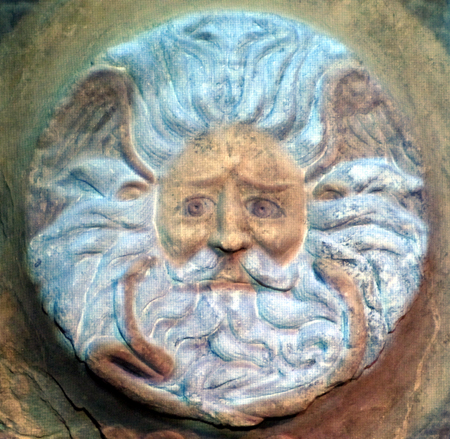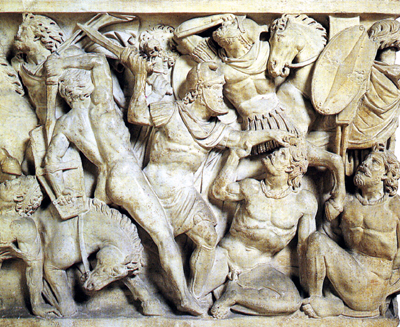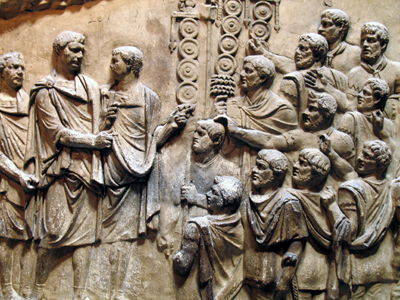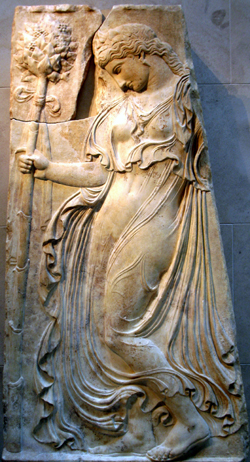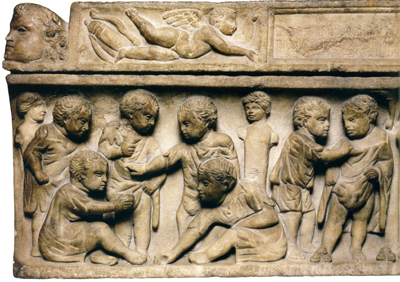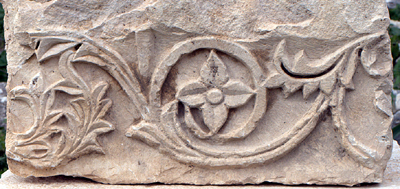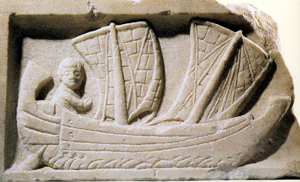|
Roman Reliefs
A relief is a stone carving usually on a flat slab of stone, so there is a flat stone background. This is different to a statue which is carved out of a block of stone to stand freely, with no background.
Ancient peoples like the Roman carved many reliefs, mostly for buildings and gravestones. The scenes often show people, like shopkeepers, emperors, or soldiers, and sometimes animals and buildings, or often leaves and flowers for decoration. Some reliefs, like those found in temples, show gods.
The picture to the right shows Brigantia, the god of the Brigantes tribe of northern Britain. This was a Celtic god and so it was carved by a Celtic artist, but the style is Roman, and Brigantia is shown with some of the features of the Roman god Minerva (the spear and shield, and the head of Medusa on her chest).
Also, the writing underneath is in Latin, the language of the Romans (the Celts had no writing for their own language). So the Celts borrowed ideas from the Romans - and the Romans borrowed ideas from the Celts too.
The skill of the Roman stonemasons was amazing, as you can see from the examples on this page.
A gorgon, associated with the Roman goddess Minerva. This carving was on the front of the temple of the god Sulis-Minerva, who is a mixed Celtic goddess (Sul) and Roman goddess (Minerva). It was found at Bath, which the Romans named Aquae Sulis after the god. The hot springs at Bath were sacred first to Sul and then to Minerva, who was a goddess of healing. People came to the baths and prayed and left offerings to Sulis-Minerva, hoping the goddess would cure their ills.
The carving was in the middle of the pediment above the temple of Sulis-Minerva in the grounds of the baths (learn more about this here). You can see wings and snakes around the head - this shows it represents Medusa, a monster whose head was worn on Minerva's breastplate after she was killed by Perseus.
And yet the gorgon has a flowing moustache and hair sticking up in bunches, which is the style of a Celtic man. Warriors would smear lime in their hair to made it stand up and look scarier for battle. So like the relief of Brigantia, this carving shows how the Romans and Celts joined together their two styles of art, and their two cultures.
The carving would have been painted, and the picture below shows what these colours might have been (at the Bath museum they shine lights on the pediment - follow the link above to see this).
|
Brigantia
A very similar relief to the one above - this one was found at Bath and shows Minerva again. You can see the gorgon's head on her breast as well as the spear in her hand.
A tombstone showing a Roman cavalryman killing an enemy.
|
|
Roman soldiers fighting Celts. The Celts often fought naked. You can see them wearing torcs round their necks. |
Roman soldiers forming a testudo (tortoise) with their shields. This protected them from missiles like arrows, while they attacked a city wall.
|
|
The emperor Trajan addressing his soldiers. From Trajan's column in Rome.
|
The head of a Roman soldier carved in marble. |
|
An amazing carving from the Ara Pacis - a shrine built in the time of Emperor Augustus in Rome. |
Another beautiful carving, of a maenad - a worshipper of the god of wine, Bacchus.
|
|
A clothes-seller's shop. Looks like cushions hanging above. |
A butcher's shop, with meat hanging above. |
|
Boys playing. From a sarcophagus (stone coffin).
|
A wild boar and a hunting dog. |
|
A carving of flowers and leaves. |
A ship. |

